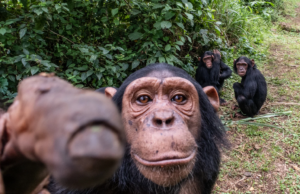How long does a chimpanzee live?
 Chimpanzee Francis, 50 years-old, she was born in Africa. When she was a baby was caught and taken to North-American medical experiment centers and zoos. She had several of her children stolen, was transfered to a zoo in Bolivia, where she almost died of starvation. She was rescued by GAP Project, lives with Charles and has yet reproductive capability.
Chimpanzee Francis, 50 years-old, she was born in Africa. When she was a baby was caught and taken to North-American medical experiment centers and zoos. She had several of her children stolen, was transfered to a zoo in Bolivia, where she almost died of starvation. She was rescued by GAP Project, lives with Charles and has yet reproductive capability.
This question has already been made hundreds of times over the 14 years of our lives involved with chimpanzees. Our answer, to simplify the subject, has usually been: LIKE US. If the same question is asked to professionals of zoos, the answer is 35 years. Both answers are, in the strict sense, WRONG.
In the forest it is estimated that a chimpanzee lives up to 35 years, especially in recent decades, with the threat that he suffers from hunters, smugglers, loggers and miners to clean the area where they operate. Besides the human threat, which reduced n 50% the population in the wild in a few years, the dangers that the jungle offers are immense, and enemies, from small insects to large predators, are numerous. The result is that chimps must sleep on the nuisance of treetops in a new nest they make every day, in different places. This is a form of survival.
With chimpanzees in captivity, the situation changes, but not as much as it should. In zoos, due to the stress generated for years, with public harassment in small enclosures with no possibility of exercise and to live harmoniously in a group, life expectancy is drastically reduced. If the jungle is a dangerous place to live, zoos are more dangerous. Human diseases are transmitted in infinite ways, due to the close contact, and unbalanced mind generates disturbances and self-mutilation that end up destroying lives.
In theory, our answer, LIKE US, should be correct, but it is not. Even they are able to communicate with us at the Sanctuary, where the most ideal conditions of life in captivity are offered, chimpanzees are not able to explain clearly to us the pain and problems that disturb them, as humans do, which serves to detect early a lot of diseases. Some chimpanzees show us the wounds so that we treat it, or show us some pain so we can kill it. Especially those more civilized, they know we have the ability to heal.
The simple fact of drawing blood to assess the overall condition is possible in some primates with their consent, but in others not. For these we need to anesthetize, and most of the times from distance, which makes anesthesia inaccurate and can generate overdose and respiratory and cardiac arrest. Every day, across the world, there are dead animals in zoos resulted of inaccurate anesthetics processes.
When we need to do surgery things get harder. Most veterinarians in the world do not have training to understand the body of a great primate, which is almost equal to a human. The vast majority of veterinary schools on the planet does not have a detailed course of the body of a great ape. Therefore we have to resort to human experts, who are afraid to operate a primate until they realize that they are equal us. Some veterinarians also claim corporative reasons to avoid that the apes are assisted by human physicians in these situations.
However, the problem does not stop there. The big problem is the post-operative period. Maintaining a chimpanzee immobilized the required period of an operation recovery is a quite impossible task, because it is necessary a few days of rest for a full recovery. This greatly reduces the possibilities we have to cure them when the only way is surgery.
Take Carol’s case, a 30-year-old female chimpanzee who lived at Sorocaba Sanctuary, known as the intellectual as she walked with magazines and flipped them all day. She lived for 10 years with us, with several males, such Gilberto, Alex, and Luke, this last one whom she was in love with. She died within two months after an aggressive cancer skin appeared around her left breast and finished hitting her chest and part of her back. Nothing could be done apart the fact it was diagnosed by a biopsy and the pain was mitigated with medicines. Surgery followed by radiotherapy or chemotherapy would be possible, things that a human would do with some chance of healing, since detection was premature.
We have received many adult chimpanzees with sequelae of a lifetime of abuse, poor food, permanent stress, and even erroneous medical treatment, lack of knowledge and resources from their captors. These sequelae end manifesting in poor health and premature death, which in normal cases would not happen. It is the same situation of human populations depleted by poor living conditions. Life expectancy of many people in the XXI century still does not exceed 50 years, when in developed economies a Homo sapiens reaching 100 years-old is no longer a rarity.
We hope that serious Sanctuaries, home to the new generations of chimpanzees, which have ideal conditions for maintenance, showing a good care with resources and affection – although a captive life will never be the ideal -, may extend the lives of great apes, like humans..

 Español
Español
 Português
Português








